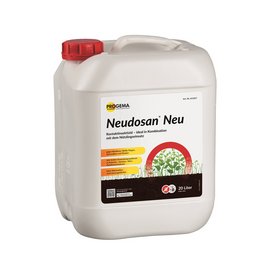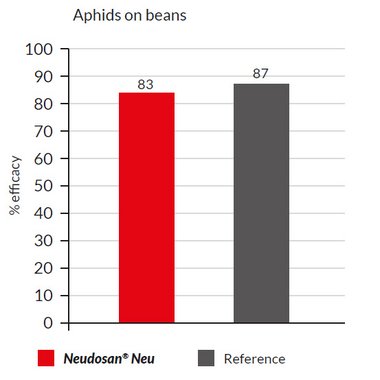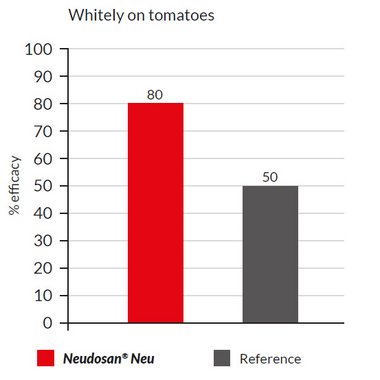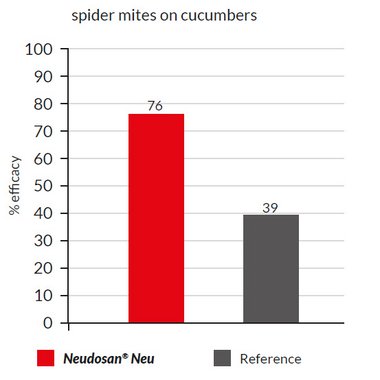Package sizes:
Active ingredient
515 g/l potassium salts of natural fatty acids
The active ingredients of Neudosan® Neu are potassium salts of natural fatty acids. Neudosan® Neu is made from fatty acids selected for their insecticidal effect.
Mode of Action
After spraying with Neudosan® Neu, insects quickly die. The active ingredient disrupts the cell structure of soft-bodied insects causing the cell contents to leak out. The pests dehydrate in the spray liquid. It also damages the respiratory organs. In contrast to insecticides, which attack the nervous system of insects, the dead pests remain attached to the leaves for a short while before they wither and drop off.
Use of beneficial organisms
Neudosan® Neu makes the perfect complement to beneficial insect use. Neudosan® Neu can be applied up to a few hours before using beneficial insects because once the spray has dried, there is no risk to beneficial organisms. If beneficial insects are present, Neudosan® Neu can be applied for partial control of infestation.
Organic farming
Neudosan® Neu is certified in accordance with EU regulations for agricultural use by farms operating on organic principles.
Efficacy
Test results with Neudosan® Neu (effectiveness, mean value from 4 or 6 tests)
Plant compatibility
Transplanted, newly rooted plants should not be treated with Neudosan® Neu.
Ornamental plants: Cyclamen, violets, ivy, fuchsias, Calceolaria, poinsettias, Christ’s thorn, ferns, types of dracaena and sunflowers can be sensitive to treatment with Neudosan® Neu. New growth on greenhouse roses during the winter season may be damaged if directly treated with Neudosan® Neu. Flowers may not tolerate Neudosan® Neu. Testing a few plants for sensitivity before treating large collections is highly recommended.
Fruit growing: Neudosan® Neu has a slight thinning effect when sprayed during the flowering stage. Sensitive apple varieties can experience russeting if treated during and shortly after flowering. Neudosan® Neu may cause leaf burn if sprayed on varieties such as Braeburn, Gala and Kanzi. Some plum varieties (e.g. Ersinger) may lose their typical blue colour.
Vegetable gardening: Neudosan® Neu is mostly tolerated by plants. Basil plants may react with necrosis on leaves if they are treated with Neudosan.
Application
Neudosan® Neu is applied as a 2 % solution.
The following should be noted:
1. Spray application with a high water volume
Neudosan® Neu works only on direct contact. Therefore, the plants must be thoroughly wetted from all sides. It cannot be used in a fogger.
2. Mix the spray liquid with soft water
Water hardness above 250 mg/l calcium carbonate decreases the effectiveness. High iron content in the water can also reduce the effectiveness.
3. Spray at low temperatures and little direct sunlight
The best time to spray with Neudosan® Neu is in the early morning or late evening when temperatures are cooler and humidity is higher. The longer the plant surface remains wet after spraying (at least 10 minutes), the more effective the treatment.
4. Recommendations
Neudosan® Neu is effective against adult insects and older larval stages of whitefly as well as spider mite control. Repeat the application at intervals of 5-7 days to control the pests hatching from eggs or young larvae at a later stage. The spray should be applied in the early morning hours when the adult insects are still inactive on the leaves.
Examples for Dose rates/Areas of application
| Plants | Pests | Areas of appication | Application rates | |
|---|---|---|---|---|
| Farmland | ||||
| Field beans | Sucking insects | 18 L in 180 L water/ha | ||
| Field peas | Sucking insects | |||
| Lupin species | Sucking insects | |||
| Fruit Growing | ||||
| Pome fruit | Sucking insects (except woolly aphid and pear psyllids) Spider mites | Open field | 10 L in 500 L water/ha per metre of crown height | |
| Stone fruit | Sucking insects | Open field | ||
| Soft fruit | Sucking insects | Open field | 20 L in 1000 L water/ha | |
| Strawberries | Aphids | Open field | 40 L in 2000 L water/ha | |
| Ornamental Plants | Ornamental plant/shrubs | Aphids (incl. Sitka spruce aphid, except woolly broadleaf tree and conifer aphids and gall-forming aphids) Spider mites Whitefly |
Open field greenhouse Open field, greenhouse Greenhouses | Crop height: < 50 cm: 18 L in 900 L water/ha 50-125 cm: 27 L in 1350 L water/ha > 125 cm: 36 L in 1800 L water/ha |
| Vegetable gardening | ||||
| Leaf and stem vegetables | Aphids (except mealy cabbage aphid) | Open field | Crop height: < 50 cm: 18 L in 900 L water/ha 50-125 cm: 27 L in 1350 L water/ha > 125 cm: 36 L in 1800 L water/ha |
|
| Fruiting vegetables | Whitefly Aphids, spider mites | Greenhouses Open field, greenhouse | ||
| Leaf vegetables & fresh herbs | Sucking insects | Greenhouses | ||
| Bulb vegetables and legume vegetables | Sucking insects | Open field | ||
| Brassica, root and tuber vegetables | Sucking insects | Open field, greenhouse | ||
| Bean sprouts and young vegetable plants | Sucking insects | Greenhouses |
Environmental compatibility data
Beneficial organisms: Harmless to predatory mites (Typhlodromus pyri), lacewings and ladybirds. It is slightly harmful to predatory mites (Amblyseius andersoni) and chalcidoid wasp (Trichogramma cacoeciae). Harmful to hover flies.
Bees: Product is not harmful to bees. (German registration)
Water: No requirements regarding water protection areas. The product is toxic to fish food sources but non-toxic to fish. Waters distance conditions: see www.progema.de
Preharvest interval: None
Hint
This product information does not replace the instructions for use. Please refer to the instructions for use for current application regulations and certification procedures. Use insecticides with care. Always read the label and product information sheet before use. Pay attention to warnings and warning symbols in the instructions.
Distribution
Downloads
-
Neudosan.pdf (1 MB)
For further information please visit the download-center






